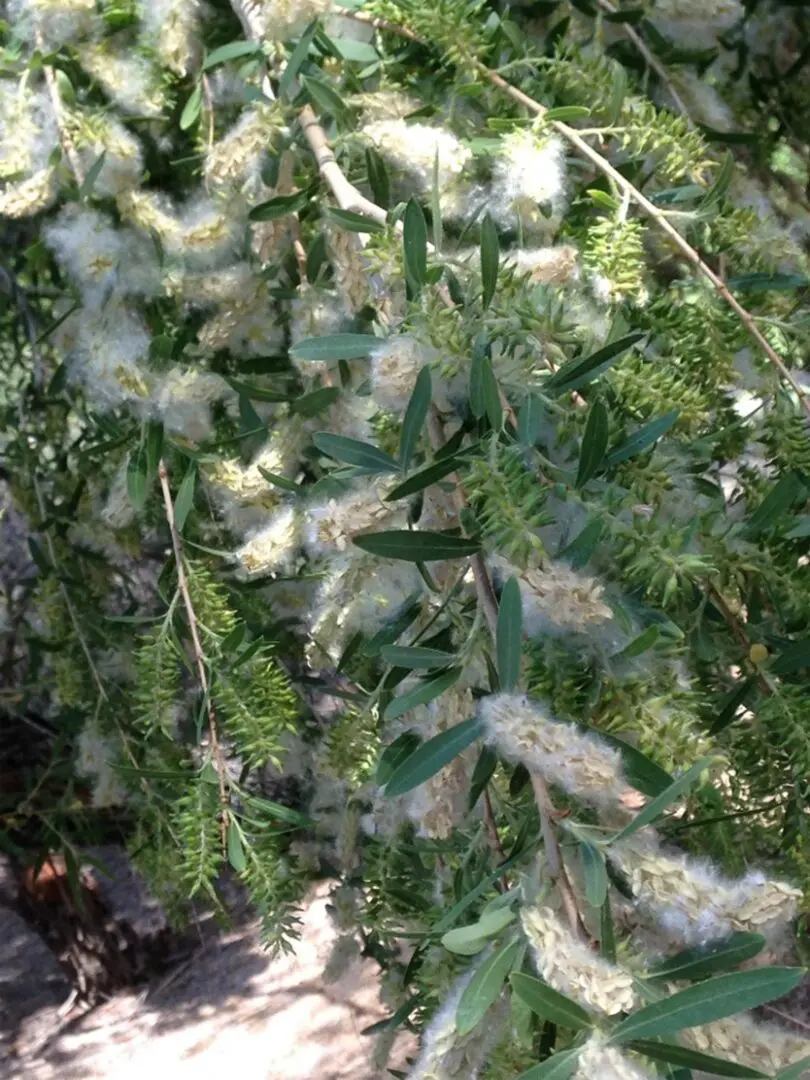The Sandbar Willow

what under-valued wetlands park tree looks like a shrub?
The clumping sandbar willow (Salix exigua), averaging four to 15 feet tall, with its densely packed stems and no main trunk, really doesn’t look like a classic shade tree This member of the Willow Family (Salicaceae) is native from the Yukon River in central Alaska across the interior United States – as far east as the Mississippi River in southern Louisiana – the largest range of any of the 129 Salix willow species in North America. Also known as coyote willow and narrowleaf (or narrow-leaf) willow, the shrub’s cool green foliage is common in the riparian “ribbon of green” on the banks of streams, including those found in Clark County Wetlands Park.
At the Park, sandbar willows have expanded from the original plantings into pond and stream-edge communities, sharing the waterside spaces with the larger Fremont cottonwoods (Populus fremontii) and closely related Goodding willows (Salix gooddengii). They are lovely to look at and great at competing with cattails, which are always trying to turn the Park’s open water ponds into marshes. They make a great screen for Park visitors to peek through in search of waterfowl and other wildlife.
Sandbar willow leaves are narrow and lanceolate (oval shaped with tapered points at each end), with smooth margins or a few irregular, widely spread small “teeth” along their edges. In spring after the leaves appear, bright yellow flowers are produced in catkins (slim, cylindrical flower clusters). The fruit that follows are clusters of capsules, each with many very tiny seeds embedded in shiny white silk. The seeds are dispersed by wind and by water. But that’s not the only way Sandbar willow spreads. A single plant can also grow numerous basal shoots or roots to establish a colony. Because of its extensive root system, sandbar willow is excellent for stabilizing the banks and even the bottoms of streams in areas where floods are common.
The sandbar willow plays other important roles in riparian habitats. Large and small mammals, waterfowl, and other birds browse its leaves, buds, and shoots in search of insects among its branches and foliage. At the Park, it is a favorite food of resident beavers. Its densely packed twigs and branches provide safe nesting space and cover for birds that prefer to nest in dense thickets, including the endangered southwest willow flycatcher. Its flowers are an important pollen source for many native bees, and it is a host plant for a variety of butterfly species, including the mourning cloak, California hairstreak, sylvan hairstreak, Lorquin’s admiral, and western tiger swallowtail.
For early Native American tribes, the sandbar willow’s “goods” rivaled those found in a department store. Its flexible branches were used in building shelters and making baskets (warp in twined baskets and foundation in coiled ones), arrow shafts, scoops, and fish traps. Its bark was turned into cordage, and both the bark and leaves had various uses as medicines. The southern Nevada Paiutes harvested willow in the winter. After careful preparation, the plant was transformed into a wide variety of woven items. The long list includes water jugs, infant cradles, hats, cooking vessels, serving bowls, winnowing trays, seed beaters, and storage baskets.
Take time to appreciate the very useful sandbar willow when you visit the Park. These small trees may have a Latin name that means a “small, thin, slender, feeble, or weak” willow, but don’t let their name fool you. They do work in the Park’s habitats that is out of all proportion to the size of the individual trees!
– By Chris Leavitt, President; photo by Gail Raffel
Please enjoy these YouTube videos!
General information on Sandbar willow
www.youtube.com/watch?v=vgJYjMfiS_l
Using Sandbar willow for bank stabilization at a cultural site
www.youtube.com/watch?v=MAH9yVITboc
Planting Sandbar willow poles
